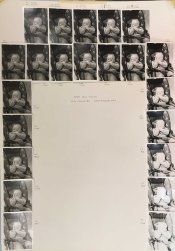Exposing paper to let's say:
10s @ 2.5
or
5s @ 0
5s @ 5
shouldn't that give me the same outcome?
I always find my exposure time at grade 2.5 first.
I then try a straight print at 2.5 and then do the same at 50% 0 and 50% grade 5.
The split grade alway looks more pleasing. It seems to have slightly more contrast, but still gives details in the shadows. (used MCC and MGFB papers)
How does that make sense when the combination of the two extremes should give me the middle. My starting point.
10s @ 2.5
or
5s @ 0
5s @ 5
shouldn't that give me the same outcome?
I always find my exposure time at grade 2.5 first.
I then try a straight print at 2.5 and then do the same at 50% 0 and 50% grade 5.
The split grade alway looks more pleasing. It seems to have slightly more contrast, but still gives details in the shadows. (used MCC and MGFB papers)
How does that make sense when the combination of the two extremes should give me the middle. My starting point.






